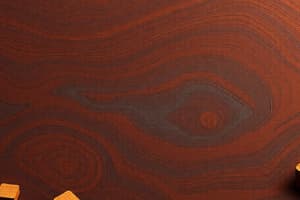Podcast
Questions and Answers
What is wood finishing?
What is wood finishing?
- The process of cutting and shaping wood
- The process of refining or protecting a wooden surface (correct)
- The process of joining pieces of wood together
- The process of painting wood
What percentage of manufacturing costs in furniture production does finishing typically represent?
What percentage of manufacturing costs in furniture production does finishing typically represent?
- 20-30% (correct)
- 30-40%
- 5-10%
- 10-20%
What are some of the desirable characteristics that finishing gives wood surfaces?
What are some of the desirable characteristics that finishing gives wood surfaces?
- Increased resistance to scratches
- Increased resistance to moisture (correct)
- Increased resistance to fire
- Increased resistance to pests
What should be considered when planning for finishing?
What should be considered when planning for finishing?
What is the purpose of sanding before finishing?
What is the purpose of sanding before finishing?
What are some larger defects that should be removed before finishing?
What are some larger defects that should be removed before finishing?
What is the purpose of staining wood?
What is the purpose of staining wood?
What are some of the factors considered when choosing a clear finish for wood?
What are some of the factors considered when choosing a clear finish for wood?
What are some of the benefits of automated wood finishing systems?
What are some of the benefits of automated wood finishing systems?
Flashcards
Wood Finishing
Wood Finishing
The process of refining or protecting a wooden surface, enhancing its appearance and resistance to wear.
Sanding (Wood Finishing)
Sanding (Wood Finishing)
Removing defects from the wood surface to ensure a smooth and even finish.
Wood Staining
Wood Staining
Changing the color of wood using dyes, stains, or pigments to modify the finish.
Top Coat (Wood Finishing)
Top Coat (Wood Finishing)
Signup and view all the flashcards
Hangline Approach (Automated Wood Finishing)
Hangline Approach (Automated Wood Finishing)
Signup and view all the flashcards
Towline Approach (Automated Wood Finishing)
Towline Approach (Automated Wood Finishing)
Signup and view all the flashcards
Rotating Top Platens (Automated Wood Finishing)
Rotating Top Platens (Automated Wood Finishing)
Signup and view all the flashcards
Automated Wood Finishing
Automated Wood Finishing
Signup and view all the flashcards
Successive Coat Application (Automated Wood Finishing)
Successive Coat Application (Automated Wood Finishing)
Signup and view all the flashcards
Study Notes
Wood Finishing: A Detailed Guide
-
Wood finishing is the process of refining or protecting a wooden surface, typically representing between 5 and 30% of manufacturing costs in furniture production.
-
Finishing gives wood surfaces desirable characteristics, including enhanced appearance and increased resistance to moisture and other environmental agents.
-
Planning for finishing involves thinking about the properties of the wood being finished, as these can greatly affect the appearance and performance of finishes.
-
Sanding is carried out before finishing to remove defects from the wood surface that will affect the appearance and performance of finishes that are subsequently applied to the wood.
-
Larger defects that interfere with wood finishing include dent, gouges, splits and glue spots and smears, which should also be removed before finishing.
-
Wood surfaces are occasionally affected by various organic and inorganic stains, which can be removed from wood using bleach.
-
Wood can be stained to change its color or left unstained before application of lacquer, or other types of top-coats.
-
Wood finishing starts with sanding either by hand, scraping, or planing.
-
Once the wood surface is prepared and stained, the finish is applied, usually consisting of several coats of wax, shellac, drying oil, lacquer, varnish, or paint.
-
Clear finishes are intended to make wood look good and meet the demands to be placed on the finish, involving trade-offs between appearance, protection, durability, safety, requirements for cleaning, and ease of application.
-
Manufacturers who mass-produce products implement automated flatline finish systems, consisting of a series of processing stations that may include sanding, dust removal, staining, sealer and topcoat applications.
-
Automated wood finishing methods involve the use of spray guns in an enclosed environment or spray cabin, and the material can also be sanded again depending on the manufacturer’s setup.Automated Wood Finishing
-
Automated wood finishing involves the use of machines to apply finish to wood products.
-
The two approaches used in automated wood finishing are the hangline approach and towline approach.
-
In the hangline approach, wood items are hung by carriers or hangers that are attached to a conveyor system.
-
The conveyor system can be ceiling mounted, wall mounted or supported by floor mounts.
-
The towline approach uses mobile carts that are propelled by conveyors mounted in or on the floor.
-
The towline approach is useful for moving large, awkward shaped wood products that are difficult or impossible to lift or hang overhead.
-
The mobile carts used in the towline approach can be designed with top platens that rotate either manually or automatically.
-
The rotating top platens allow the operator to have easy access to all sides of the wood item throughout the various wood finishing processes.
-
The hangline approach allows items to be moved up to warmer air at the ceiling level to speed up drying process.
-
Automated wood finishing systems can be designed to add successive coats depending on the layout of the production line.
-
Automated wood finishing systems can increase efficiency and reduce labor costs.
-
Automated wood finishing systems can also increase consistency and reduce the risk of human error.
Studying That Suits You
Use AI to generate personalized quizzes and flashcards to suit your learning preferences.




